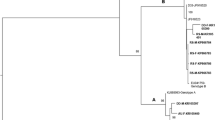Abstract
The aim of this study is to evaluate the serological levels of zinc, copper and iron in Giardia lamblia-infected children and to study the effect of giardiasis on their weight compared to controls. We studied 30 children, 1–10 years old, who attended the outpatient clinics of Cairo university pediatric hospital, with gastrointestinal complaints and diagnosed as having giardiasis by stools examination, they were enrolled as a study group. The control group consisted of 30 age- and sex-matched healthy children, free of gastrointestinal complaints and free of giardiasis. Serological levels of zinc, copper, and iron were measured by atomic absorption spectrophotometer. The infected group had significantly lower weight, serum iron, and zinc than controls (P = 0.035, <0.001, and <0.001 respectively) and 63.3% of patients infected with giardiasis were 1–5 years old. In the infected cases, 60% suffered from of abdominal pain, 50% from weight loss, and 40% had intermittent diarrhea. Infected cases with weight percentiles below the fifth had significantly lower serum iron than those with normal percentiles (>5th). In conclusion, most giardiasis-infected children were between 1 and 5 years, with significant affection of weight, abdominal pain, and/or intermittent diarrhea. Serum zinc and iron levels were significantly decreased in the infected group compared to control (P < 0.001).
Similar content being viewed by others
References
Coles CL, Levy A, Dagan R, Deckelbaum RJ, Fraser D (2009) Risk factors for the initial symptomatic giardia infection in a cohort of young Arab-Bedouin children. Ann Trop Paediatr 29:291–300
Savioli L, Smith H, Thompson A (2006) Giardia and cryptosporidium join the 'neglected diseases initiative'. Trends Parasitol 22:203–208
Ensink JH, van der Hoek W, Amerasinghe FP (2006) Giardia duodenalis infection and wastewater irrigation in Pakistan. Trans R Soc Trop Med Hyg 100:538–542
Farthing MJ (1992) New perspectives in giardiasis. J Med Microbiol 37:1–2
Parija SC (2004) Intestinal, oral and genital flagellates. In: Textbook of Medical Parasitology (Protozoology and Helminthology) 2nd edition. All India Publisher and Distributor, Chennai, pp 62–70
Karakas Z, Demirel N, Tarakcioglu M, Mete N (2001) Serum zinc and copper levels in southeastern Turkish children with giardiasis or amebiasis. Biol Trace Elem Res 84:11–18
Ertan P, Yereli K, Kurt O, Balcioglu IC, Onag A (2002) Serological levels of zinc, copper and iron elements among Giardia lamblia infected children in Turkey. Pediatr Int 44:286–288
Garcia LS (1990) Laboratory methods for diagnosis of parasitic infections. In: Baron EJ, Finegold SM (eds) Bailey and Scott's diagnostic microbiology, 8th edn. C. V. Mosby, St. Louis, pp 776–861
Squitti R, Lupoi D, Pasqualetti P, Dal Forno G, Vernieri F, Chiovenda P, Rossi L, Cortesi M, Cassetta E, Rossini PM (2002) Elevation of serum copper levels in Alzheimer's disease. Neurology 59:1153–1161
Reynoldson JA, Behnke JM, Gracey M, Horton RJ, Spargo R, Hopkins RM, Constantine CC, Gilbert F, Stead C, Hobbs RP, Thompson RC (1998) Efficacy of albendazole against Giardia and hookworm in a remote Aboriginal community in the north of Western Australia. Acta Trop 71:27–44
Culha G, Sangun MK (2007) Serum levels of zinc, copper, iron, cobalt, magnesium, and selenium elements in children diagnosed with Giardia intestinalis and Enterobiosis vermicularis in Hatay, Turkey. Biol Trace Elem Res 118:21–26
Heresi G, Cleary TG (1997) Giardia. Pediatr Rev 18:243–247
Muller N, von Allmen N (2005) Recent insights into the mucosal reactions associated with Giardia lamblia infections. Int J Parasitol 35:1339–1347
Gendrel D, Treluyer JM, Richard-Lenoble D (2003) Parasitic diarrhea in normal and malnourished children. Fundam Clin Pharmacol 17:189–197
Stephenson LS, Latham MC, Ottesen EA (2000) Global malnutrition. Parasitology 121(Suppl):S5–S22
Carvalho-Costa FA, Goncalves AQ, Lassance SL, Silva Neto LM, Salmazo CA, Boia MN (2007) Giardia lamblia and other intestinal parasitic infections and their relationships with nutritional status in children in Brazilian Amazon. Rev Inst Med Trop Sao Paulo 49:147–153
Simsek Z, Zeyrek FY, Kurcer MA (2004) Effect of Giardia infection on growth and psychomotor development of children aged 0–5 years. J Trop Pediatr 50:90–93
Sawaya AL, Amigo H, Sigulem D (1990) The risk approach in preschool children suffering malnutrition and intestinal parasitic infection in the city of Sao Paulo, Brazil. J Trop Pediatr 36:184–188
Lunn PG, Erinoso HO, Northrop-Clewes CA, Boyce SA (1999) Giardia intestinalis is unlikely to be a major cause of the poor growth of rural Gambian infants. J Nutr 129:872–877
Saldiva SR, Silveira AS, Philippi ST, Torres DM, Mangini AC, Dias RM, da Silva RM, Buratini MN, Massad E (1999) Ascaris-Trichuris association and malnutrition in Brazilian children. Paediatr Perinat Epidemiol 13:89–98
Silva RR, da Silva CA, de Jesus Pereira CA, de Carvalho Nicolato RL, Negrao-Correa D, Lamounier JA, Carneiro M (2009) Association between nutritional status, environmental and socio-economic factors and Giardia lamblia infections among children aged 6–71 months in Brazil. Trans R Soc Trop Med Hyg 103:512–519
Demirci M, Delibas N, Altuntas I, Oktem F, Yonden Z (2003) Serum iron, zinc and copper levels and lipid peroxidation in children with chronic giardiasis. J Health Popul Nutr 21:72–75
Roxstrom-Lindquist K, Palm D, Reiner D, Ringqvist E, Svard SG (2006) Giardia immunity—an update. Trends Parasitol 22:26–31
Hawrelak J (2003) Giardiasis: pathophysiology and management. Altern Med Rev 8:129–142
Acknowledgment
Thanks to Prof. Dr. Amal El Saffty, professor of industrial medicine, Cairo University, Egypt, for carrying out most of the laboratory work of this study.
Author information
Authors and Affiliations
Corresponding author
Rights and permissions
About this article
Cite this article
Abou-Shady, O., El Raziky, M.S., Zaki, M.M. et al. Impact of Giardia lamblia on Growth, Serum Levels of Zinc, Copper, and Iron in Egyptian Children. Biol Trace Elem Res 140, 1–6 (2011). https://doi.org/10.1007/s12011-010-8673-6
Received:
Accepted:
Published:
Issue Date:
DOI: https://doi.org/10.1007/s12011-010-8673-6




